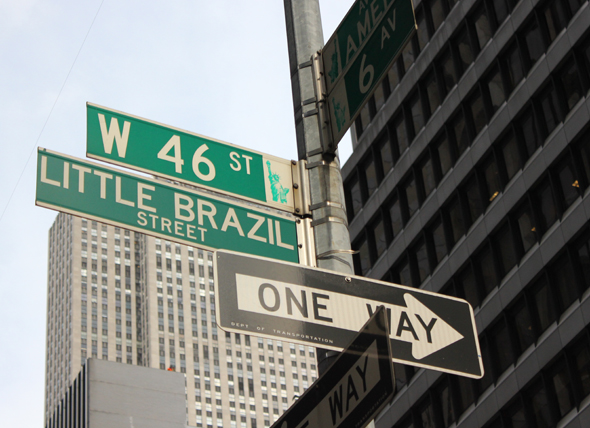
Thirty thousand Brazilians immigrated to New York last year, according to the U.S. Census Bureau’s 2010 American Community Survey, but they seem to be gathering anywhere but Little Brazil, once a cultural mecca of the green, blue and yellow flag.
A Little Brazil street sign has stood for 16 years at the corner of West 46th Street and Seventh Avenue, with two more at Sixth and Fifth Avenues, but the center of the neighborhood has shifted from its once vibrant center to the eastern edge of the defined area, past O’Brien’s Irish Pub, John’s Shanghai Chinese Restaurant and concrete commercial high rises.
The only remaining remnants of Little Brazil are the Consulate General of Brazil and a scatter of churrascarias and restaurants, a travel agent, a shop that sells Brazilian food, clothing and accessories and the local newspaper, The Brazilians. With a nationwide circulation of 60,000, the monthly bilingual newspaper had tried for 40 years, in Portuguese and English, to reach Manhattan’s Brazilian community.
Ediberto Mendez, editor of The Brazilians, was adamant that the newspaper would stay in its current location in Little Brazil, saying that the street is symbolic of the epicenter of the wide Brazilian community in New York, even if the day-to-day Brazilian community’s presence is diminishing.
Restaurant manager at Via Brasil, Ronald DeSouza, said that people are still drawn to the street for authentic Brazilian cuisine. The restaurant is one of the longest-standing landmarks in Little Brazil, celebrating its 32nd birthday this year, but it has not survived without cutbacks. The restaurant’s most recent change, although a small one, was a decrease in the number of nights it features live music, from three to two. Restaurant by restaurant, other businesses have closed down permanently in Little Brazil, like Mara’s, a Brazilian restaurant on West 46th Street, that has been boarded up and advertised as space for rent for over four months.
Marcela De Ramos has run Buzio’s in Little Brazil for six years (although the store has existed for at least 20 years), selling Brazilian food, clothing, beauty products and books; to her the only economic threat to Little Brazil is the increases in the already expensive cost of renting. Otherwise, she maintains an optimistic attitude. “Business has been pretty constant since I’ve been here,” De Ramos said. “But Brazilians are not really faithful to one area, we get involved with other cultures too,” which she thinks is the reason that Little Brazil looks more diluted than the once culturally booming street appeared.
Little Brazil has been deteriorating for many decades due to a series of recent changes, including the tightening of U.S. immigration and visa policies introduced in 2004-2005, when the influx of Brazilian immigrants begin to slow down. “What we saw earlier in the decade was a sudden increase in the Brazilian population in 1999-2000,” said Aaron Terrazas, policy analyst at the Migration Policy Institute in Washington D.C. “Things were gradually improving in Brazil and it was fairly easy to obtain a visa,” even though there had always been stringent criteria for entry into the U.S., including proof of earnings and education.
Terrazas added that while Brazilian immigration has slowed in the past decade or so, the trend predates the economic crisis of 2008, ruling out tough financial conditions in the U.S. as a direct cause. He describes the current immigration rates as “fairly stable,” but notes that Brazil has seen some small returns of immigrants back to Brazil, since their economy has also recently strengthened.
Maxine L. Margolis, Professor Emerita of Anthropology at the University of Florida, said that Brazilian immigrants had arrived in the U.S. with the promise of an opportunity to improve their English and for well-paid jobs in the early 1990s, with the intention of returning home after a two to three years. The theory went, “One week in New York was worth four weeks in Brazil,” said Margolis.
Today, New York’s Brazilian population resides largely in Astoria, Queens, though some live further from Manhattan, like Carla Collier, who immigrated six years ago. Collier doesn’t normally make the trip from her home in upstate New York to Manhattan to visit Little Brazil, but for celebrations of Brazil’s Independence Day on September 4th she brought her family into the city for a glimpse of the mirage that was Little Brazil revived. “It’s like a preview of Brazil. You can eat food and talk to Brazilian people even if you don’t know them,” Collier said. “My American friends love it too.” That day, a crowd estimated in the hundreds of thousands gathered for the enormous street party before the neighborhood faded back to a quiet buzz.
Ironically, the Independence Day celebration was another marker of Little Brazil’s demise. Mendez recalls a time when 1.5 million Brazilians visited Little Brazil for the holiday, but French crepes and Greek gyros have now muscled their way into the street festival, and the attendance numbers are declining.
Many of the remaining authentic Brazilian businesses on 46th Street share like-minded pessimism about the future of Little Brazil. “I don’t think it’s going back to the old days, because things are changing, times are changing,” DeSouza said. “It used to be pulsating, it use to be alive. But, the party goes on,” he added. Mendez at The Brazilians takes a gloomier tone putting Little Brazil in its current form simply: “It’s gone.”